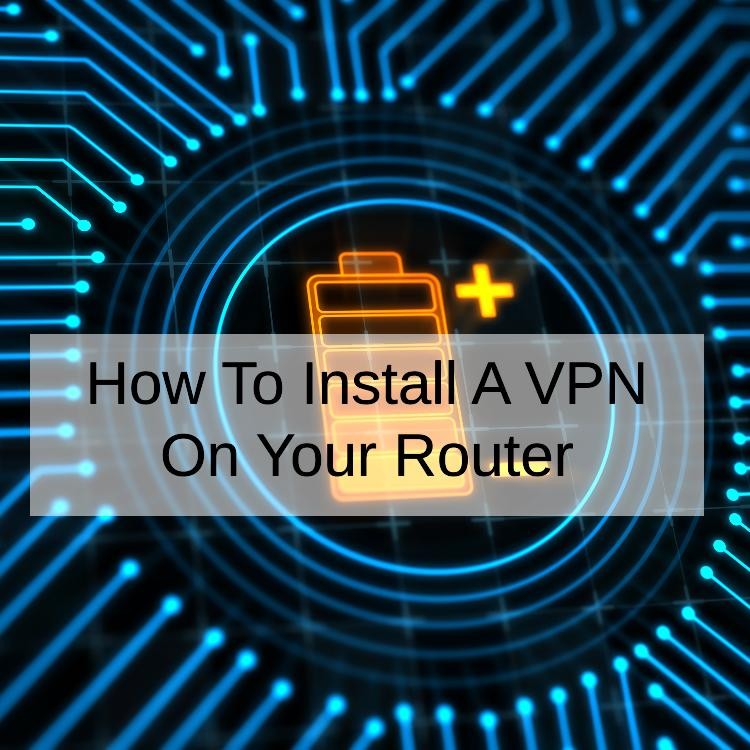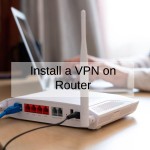In today's digital age, where privacy and security concerns are paramount, installing a Virtual Private Network (VPN) on your router has become a necessity rather than a luxury. VPNs offer a secure and encrypted connection, shielding your online activities from prying eyes and potential cyber threats. In this comprehensive guide, we will walk you through the step-by-step process of installing a VPN on your router, ensuring enhanced security and privacy for all your internet-connected devices.

Understanding VPNs
Before diving into the installation process, it's essential to grasp the fundamentals of VPNs. A VPN, or Virtual Private Network, creates a secure tunnel between your device and the internet, encrypting your data and masking your IP address. This ensures that your online activities remain private and protected from hackers, government surveillance, and other third-party entities.
There are several types of VPNs, including Remote Access VPNs and Site-to-Site vpn gateway, each serving different purposes. Remote Access VPNs allow individual users to connect to a private network remotely, while Site-to-Site VPNs enable secure communication between multiple networks across different locations.
Researching VPN Options
The first step in installing a VPN on your router is to research and choose the right VPN service provider. Consider factors such as VPN downloadoptions, compatibility with your router model, and the level of security and privacy offered.
Unbeatable Deals Await! Dive into Shurfshark Now!
When selecting a VPN provider, it's crucial to explore both paid and free options. While paid VPNs typically offer more advanced features and better performance, there are also reputable free VPN services available. Look for VPN app that are compatible with your router and provide easy-to-use interfaces for configuration.
Preparing Your Router for VPN Installation
Before installing a VPN on your router, it's essential to ensure that your router is compatible with VPN software and firmware updates. Check the manufacturer's website or user manual to determine compatibility and ensure that your router's firmware is up to date.
Updating your router's firmware is critical for ensuring compatibility with VPN software and accessing the latest security patches and enhancements. Back up your router's settings before proceeding with the firmware update to avoid any data loss or configuration errors.
Get More, Spend Less at Nord VPN Today!
Step-by-Step Installation Guide
Now that you've prepared your router for VPN installation let's dive into the step-by-step installation process
Accessing Router Settings
- Open your web browser and enter your router's IP address in the address bar (common addresses include 192.168.1.1 or 192.168.0.1).
- Log in to your router's admin console using your username and password.
Locating VPN Settings or Features
- Navigate to the VPN or Security section of your router's settings menu.
- Look for options related to VPN configuration or setup.
Choosing the VPN Connection Type
- Select the type of VPN connection you wish to use (e.g., PPTP, L2TP, OpenVPN).
- Consult your VPN provider's documentation or support resources for guidance on the recommended connection type.
Entering VPN Configuration Details
- Enter the server address provided by your VPN provider.
- Input your VPN username and password.
- Optionally, configure additional settings such as encryption protocols and authentication methods.
Saving and Applying Changes
- Once you've entered all the necessary configuration details, save your changes and apply them.
- Your router will now attempt to establish a VPN connection using the provided settings.
Deals Galore! Dive into Private VPN for Big Savings!
Testing Your VPN Connection
After configuring your vpn free on the router, it's essential to test the connection to ensure everything is working correctly. Here's how you can test your VPN connection
Verifying VPN Connectivity
- Check the status of your VPN connection in your router's settings menu.
- Verify that the connection status is "Connected" or "Active."
Checking for DNS Leaks
- Use an online DNS leak test tool to check if your DNS requests are being routed through the VPN server.
- Ensure that your DNS requests are not leaking outside of the VPN tunnel, which could compromise your privacy.
Assessing Internet Speed with VPN Enabled
- Conduct a speed test with the VPN enabled to evaluate any impact on your internet speed.
- Compare the speed test results with and without the VPN enabled to determine the performance impact.
Troubleshooting Common Installation Issues
Despite following the installation steps carefully, you may encounter some common issues when setting up a VPN on your router. Here are some troubleshooting steps to help you resolve these issues
Addressing Connection Errors
- If you encounter connection errors, double-check the VPN configuration details, including the server address, username, and password.
- Ensure that your router's firmware is up to date and compatible with the VPN software.
Resolving Compatibility Problems
- If you experience compatibility issues, consider using a different VPN connection type or updating your router's firmware to the latest version.
- Consult your VPN provider's support resources for assistance with troubleshooting compatibility problems.
Dealing with Router Firmware Incompatibility
- If your router's firmware is incompatible with the VPN software, you may need to consider using a different router or flashing custom firmware that supports VPN functionality.
- Be cautious when flashing custom firmware, as it can void your router's warranty and potentially brick the device if not done correctly.
Securing Your VPN Configuration
Once you've successfully installed and tested your VPN on the router, it's crucial to secure your VPN configuration to prevent unauthorized access and protect your privacy. Here are some tips for securing your VPN configuration
Changing Default VPN Credentials
- Change the default username and password for your VPN connection to prevent unauthorized access.
- Choose strong, unique passwords that are difficult to guess or brute force.
Enabling Firewall and Intrusion Detection Systems
- Enable the built-in firewall and intrusion detection systems on your router to protect against malicious attacks and unauthorized access.
- Configure firewall rules to restrict traffic to and from your VPN connection, ensuring that only authorized devices can access the VPN server.
Regularly Updating VPN Software and Router Firmware
- Keep your VPN software and router firmware up to date with the latest security patches and enhancements.
- Check for updates regularly and apply them as soon as they become available to mitigate security vulnerabilities and ensure optimal performance.
Exploring Additional VPN Features
In addition to basic VPN functionality, many VPN services offer advanced features and customization options to enhance your security and privacy. Here are some additional VPN features worth exploring
Configuring VPN Split Tunneling
- Split tunneling allows you to route specific traffic through the VPN tunnel while directing other traffic through your regular internet connection.
- This can be useful for accessing local network resources while connected to the VPN or optimizing performance for certain vpn application.
Setting Up VPN Kill Switch
- A VPN kill switch automatically terminates your internet connection if the VPN connection drops unexpectedly.
- This prevents your traffic from being exposed to your ISP or other third parties in the event of a VPN failure, ensuring continuous privacy and security.
Enabling Multi-Device VPN Usage
- Many VPN providers offer support for multiple simultaneous connections, allowing you to secure multiple devices with a single VPN subscription.
- Take advantage of this feature to protect all your internet-connected devices, including smartphones, tablets, computers, and smart home devices.
Detailed Comparison Across Various Aspects
Compatibility
- DD-WRT Supports a wide range of routers, but compatibility can vary.
- OpenWrt Supports a broader range of routers compared to DD-WRT.
- Tomato Generally supports fewer router models compared to DD-WRT and OpenWrt.
Ease of Installation
- DD-WRT Installation can be more complex, requiring flashing firmware and possibly risking warranty void.
- OpenWrt Similar to DD-WRT in terms of complexity but offers more customization options.
- Tomato Typically easier to install compared to DD-WRT and OpenWrt, with a more user-friendly interface.
Features and Customization
- DD-WRT Offers extensive features and customization options, suitable for advanced users.
- OpenWrt Highly customizable with a vast range of packages and configurations available.
- Tomato Features a user-friendly interface with a focus on ease of use rather than extensive customization.
VPN Protocol Support
- DD-WRT Supports a variety of VPN protocols including OpenVPN, PPTP, and L2TP/IPsec.
- OpenWrt Offers support for multiple VPN protocols, with strong emphasis on OpenVPN.
- Tomato Typically supports OpenVPN and PPTP, with some variations depending on the firmware version.
Performance and Stability
- DD-WRT Performance can vary depending on router model and firmware version but generally stable.
- OpenWrt Known for its stability and performance, particularly with newer router models.
- Tomato Offers good performance and stability, suitable for most home users.
Community Support
- DD-WRT Large and active community with extensive documentation and forums.
- OpenWrt Strong community support with active development and frequent updates.
- Tomato Community support may be somewhat limited compared to DD-WRT and OpenWrt.
Security Updates
- DD-WRT Security updates are provided but may not be as frequent as OpenWrt.
- OpenWrt Known for its robust security and frequent updates to address vulnerabilities.
- Tomato Security updates are released periodically but may not be as frequent as OpenWrt.
Optimizing VPN Performance
To get the most out of your VPN experience, it's essential to optimize your VPN configuration for performance and reliability. Here are some tips for optimizing VPN performance
Selecting the Best VPN Server Location
- Choose a VPN server location that is geographically close to your physical location to minimize latency and maximize connection speed.
- Consider server load and network congestion when selecting a server to ensure optimal performance.
Adjusting VPN Settings for Speed and Stability
- Experiment with different VPN protocols and encryption levels to find the optimal balance between speed and security.
- Disable unnecessary VPN features or services that may impact performance, such as split tunneling or kill switch.
Monitoring VPN Traffic and Usage
- Use built-in monitoring tools or third-party applications to track your VPN traffic and usage.
- Monitor bandwidth usage, connection stability, and latency to identify any issues or performance bottlenecks.
Reviewing Alternative VPN Installation Methods
While installing a VPN on your router offers comprehensive protection for all your internet-connected devices, there are alternative installation methods worth considering. Here are some alternative VPN installation methods
Installing VPN on Individual Devices
- Install VPN client software on each individual device, such as computers, smartphones, and tablets, to protect them individually.
- This approach allows for more granular control over VPN settings and configurations on each device.
Utilizing VPN Online Services
- Some VPN providers offer browser extensions or online services that allow you to connect to their vpn onlineservers without installing software on your device.
- This can be a convenient option for accessing VPN protection on devices that do not support native VPN client software.
Exploring VPN-Free Options
- In addition to paid VPN services, there are also free VPN options available that offer basic security and privacy features.
- While free VPNs may have limitations in terms of speed, bandwidth, and server availability, they can still provide an added layer of protection for your online activities.
Ensuring Legal Compliance and Privacy Protection
When using a VPN, it's essential to understand the legal implications and privacy considerations associated with VPN usage. Here are some tips for ensuring legal compliance and protecting your privacy when using a VPN
Understanding VPN Regulations in Your Jurisdiction
- Familiarize yourself with the legal regulations and requirements governing VPN usage in your country or jurisdiction.
- Some countries may have strict regulations regarding VPN usage, while others may have more relaxed policies.
Reading Terms of Service and Privacy Policies
- Read the terms of service and privacy policies of your chosen VPN provider carefully to understand their data collection and retention practices.
- Look for VPN providers that have a strict no-logs policy and do not store any personally identifiable information.
Assessing VPN Provider's Data Logging Policies
- Choose a VPN provider that has a transparent data logging policy and does not collect or store any logs of your online activities.
- Avoid VPN providers that engage in data logging or share your personal information with third parties without your consent.
Maintaining and Updating Your VPN Setup
Once you've installed and configured your VPN on the router, it's essential to maintain and update your VPN setup regularly to ensure optimal performance and security. Here are some tips for maintaining and updating your VPN setup
Regularly Reviewing VPN Performance
- Monitor your VPN connection regularly to ensure that it is performing as expected.
- Keep an eye out for any unusual behavior or performance issues that may indicate a security or configuration problem.
Updating VPN Software and Router Firmware
- Check for updates to your VPN software and router firmware regularly.
- Apply updates as soon as they become available to ensure that your VPN setup is protected against the latest security threats and vulnerabilities.
Renewing VPN Subscriptions (if applicable)
- If you're using a paid VPN service, ensure that your subscription is up to date and renewed promptly.
- Consider subscribing to longer-term plans or discounts to save money on your VPN subscription costs.
Exploring Advanced VPN Configurations
For advanced users and network administrators, there are additional configuration options and customization features available to enhance your VPN setup. Here are some advanced VPN configurations worth exploring
Implementing VPN Customization Options
- Many VPN providers offer advanced customization options, such as custom DNS settings, split tunneling, and port forwarding.
- Explore these options to tailor your VPN setup to your specific security and privacy requirements.
Integrating VPN with Advanced Networking Devices
- If you have advanced networking devices such as firewalls, routers, or network switches, consider integrating your VPN setup with these devices for enhanced security and performance.
- Consult your device's documentation or manufacturer's website for guidance on integrating VPN functionality.
Seeking Professional Assistance for Complex Setups
- If you're not comfortable configuring advanced VPN settings or integrating VPN with complex networking devices, consider seeking professional assistance.
- Hire a network security expert or IT consultant to help you design and implement a secure and reliable VPN setup tailored to your specific needs.
Installing a VPN on your router is a crucial step towards enhancing your online security and privacy. By following the step-by-step installation guide and implementing best free vpn practices for securing and optimizing your VPN setup, you can enjoy peace of mind knowing that your internet activities are protected from prying eyes and cyber threats. Whether you're a beginner or an advanced user, there are VPN options and configurations available to suit your needs and preferences. Take control of your online privacy today by installing a VPN on your router and reclaiming your digital freedom.
Commonly Asked Questions and Answers
Q Can I install a VPN on any router?
- A: Not all routers support VPN installation. You'll need to check if your router is compatible with firmware like DD-WRT, OpenWrt, or Tomato.
Q Is it difficult to install a VPN on my router?
- A: It depends on the firmware you choose and your technical expertise. DD-WRT and OpenWrt installations can be more complex compared to Tomato.
Q Which VPN protocol should I use?
- A: OpenVPN is generally recommended for its security and reliability, but PPTP and L2TP/IPsec are also supported by many routers.
Q Will installing a VPN on my router slow down my internet speed?
- A: There may be some reduction in speed due to the encryption process, but with modern routers and VPN services, the impact is often minimal.
Q Can I switch between VPN servers easily?
- A: Yes, most router firmware that supports VPN allows you to configure multiple VPN server profiles and switch between them easily.
Q:Will installing a VPN on my router affect other devices connected to it?
- A: All devices connected to the router will benefit from VPN protection, but individual devices can still be configured to bypass the VPN if desired.














